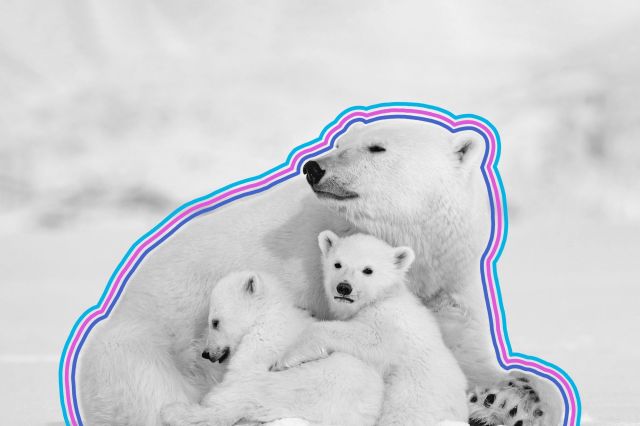
Polar Bears Are Marine Mammals
Along with their finned and flippered comrades, polar bears are considered marine mammals, which the National Oceanic and Atmospheric Administration defines as mammals that depend on oceans to thrive. Four taxonomic groups fall under this umbrella: whales, dolphins, and porpoises (Cetacea); manatees and dugongs (Sirenia); seals, sea lions, and walrus (Pinnipedia); and marine “fissipeds” (meaning “split-footed”), including polar bears and sea otters. Polar bears are also covered by the federal Marine Mammal Protection Act, which makes it illegal to harass or kill them unless human lives are threatened.

Polar Bears Are Well Adapted to Living in the Cold
Polar bears have evolved unique characteristics to survive in frequently frigid regions across Alaska, northern Canada, Greenland, and Siberia. They have translucent fur and black skin; the former lets sun penetrate the bears’ thick coats, and the latter absorbs maximum heat to keep the animals toasty in subzero temps. Underneath a bear’s hide, a four-inch-thick layer of blubber insulates its core. Polar bears also have gigantic paws — up to 12 inches in diameter — that give them stability as they walk over ice, and act like paddles when they swim. Nictating membranes (sometimes called third eyelids) help them see better underwater.

They Don’t Hibernate
Bears in more temperate parts of the world hibernate to save energy during the lean winter months; they gorge on food during summer and early fall, then snuggle into a den until spring. You might expect polar bears to hunker down and try to snooze through the coldest stretch of the Arctic winter, too. But because their food sources — seals, fish, seabirds, and even whale carcasses — remain available all year, they have no need to hibernate. Winter is actually the best time for polar bears to grab a meal. The sea ice, which the bears use like a platform to move from place to place, reaches its greatest extent and thickness in that season, making hunting easier. Only pregnant female polar bears retire to dens for the purpose of giving birth and nursing cubs.
More Interesting Reads

Polar Bears Hunt by Stealth
Polar bears have perfected a hunting method that is both sneaky and deadly. A hungry bear will sniff the air to locate a seal resting on an ice floe, then quietly slip into the water. With only its snout above the surface, the bear will paddle closer to its prey, weaving around chunks of floating ice until it is within striking distance. The bear will then leap out of the water and try to grab the seal before it can roll into the sea. The BBC Earth program The Hunt filmed a polar bear following its prey as it escaped into the water, then coming up several minutes later with the seal in its jaws. The bears also stalk seals on the sea ice with cat-like intensity.

Arctic Warming Threatens Polar Bears’ Survival
Polar bears are often held up as the poster children of climate change. The Arctic is warming up to four times faster than the rest of the world, which has caused the yearly amount of sea ice to shrink (the 10 lowest amounts recorded by satellite have all occurred in the last two decades). Less sea ice means polar bears have a harder time traveling between hunting grounds and successfully stalking prey. They also have fewer places to rest, dig dens, and raise cubs. Scientists are now seeing polar bear populations that live mainly on sea ice decrease, while those closer to land are slightly increasing.

One Canadian Town Is Dubbed “the Polar Bear Capital of the World”
Churchill, Manitoba, sits on the western coast of Hudson Bay — smack dab in the path of polar bears’ migration routes. Every summer, hundreds of bears gather around Churchill as they wait for the bay to freeze solid and herald their winter hunting season. Local guides offer polar bear viewing safaris in safely enclosed “tundra buggies” that look more like tanks. The presence of so many bears can sometimes result in unpleasant interactions with humans, so the town maintains the Polar Bear Control Program and an emergency hotline (204-675-BEAR) to protect both people and animals. Bears that get too close for comfort are temporarily removed to the area’s Polar Bear Holding Facility to await the bay’s freeze-up.











